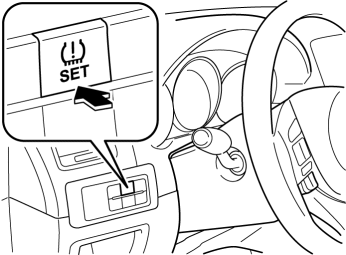Mazda CX-5 Service & Repair Manual: Tire Pressure Monitoring System Initialization Procedure
-
Perform the tire pressure monitoring system initialization when the following operations have been performed:
-
Tire pressures have been adjusted
-
Tires or wheels have been replaced
-
Tires have been rotated
-
DSC HU/CM replaced
-
DSC HU/CM connector disconnected
-
Battery replaced
-
Negative battery cable is disconnected
1. Park the vehicle on safe, level ground.
2. Adjust all four tire pressures to the specification while the tires are cold..
3. Switch the ignition ON (engine off or on).
4. Press and hold the tire pressure monitoring system set switch.

5. Press and hold the tire pressure monitoring system set switch until the tire pressure monitoring system warning light flashes 1 or 2 times and the indicator alarm sounds 1 time.
NOTE:
-
When the tire pressure monitoring system initialization is performed, learning initiates. Learning is completed by driving the vehicle for 20 min.
-
While the tire pressure monitoring system is undergoing learning, its primary functions do not operate.
 Tire Pressure Monitoring System (TPMS)
Tire Pressure Monitoring System (TPMS)
Purpose, Outline
The tire pressure monitoring system monitors the tire pressure of all 4 tires.
If the tire pressure of 1 tire or more becomes excessively low, the driver is
notified.
...
 Tire Pressure Monitoring System Set Switch
Tire Pressure Monitoring System Set Switch
Purpose
The tire pressure monitoring system set switch is used to initialize the
tire pressure monitoring system.
Construction, Operation
The tire pressure monitoring syst ...
Other materials:
Coupling Component Removal/Installation
WARNING:
When replacing the coupling component, read the special character string
before installing a new coupling component and write it to the AWD control module
after replacement. The special character string is indicated in the two locations
shown in the figure.
1. D ...
Ebd Control
Outline
EBD control uses the ABS system to control brake fluid pressure distribution
to the rear wheels so that they do not lock-up prior to the front wheels during
braking, thereby preventing the loss of handling stability.
Feature
EBD control has independent control syste ...
Drive Belt Inspection [Skyactiv G 2.0]
Generator Drive Belt
NOTE:
The generator drive belt deflection/tension inspection is not necessary with
the adoption of the drive belt auto tensioner.
1. Verify that the indicator part of the cast hexagon on the drive belt auto
tensioner is within the normal range.
If ...
